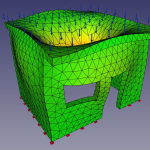Wave motion arises from local material interactions. Equilibrium of elastic and inertial forces at material points governs global wave propagation patterns. Momentum balance equations are typically expressed in the form of PDEs, which – after discretisation – yield iteration equations for numerical methods. Such an approach constitutes the top-down strategy – namely, starting from a governing equation, describing global wave motion, numerical solution for a material point is established. Conceptually different is the bottom-up approach. Here, the equilibrium is established for an elementary cell of material. A collective motion of all cells in the structure results in global response. In the area of local computational strategies we develop new and improve existing numerical methods based on the Local Interaction Simulation Approach (LISA) and Cellular Automata for Elastodynamics (CAFE or, simply, CA) – proposed and developed by Professor Michael J. Leamy.
Each strategy formulates the problem from the perspective of a cell and its local interactions with other cells, leading to robust treatments of anisotropy, heterogeneity, and nonlinearity. The local approach also enables straight-forward parallelization on high performance computing clusters. While the two share a common local perspective, they differ in two major respects. The first is that CAFE employs both rectangular and triangular cells, while LISA considers only rectangular. The second is that LISA appeared much earlier than CAFE (early 1990’s versus late 2000’s), and as such has been developed to a much greater degree with a multitude of material models, cell-to- cell interactions, loading possibilities, and boundary treatments. The LISA has been implemented into cuLISA3D software for fast and reliable simulation of elastic wave propagation (see software’s webpage http://www.monitshm.pl/en/index.php?loc=lisa). The software utilises Graphical Processing Units (GPUs) to speed up computations by factor of hundreds.
Local computational strategies for wave propagation

